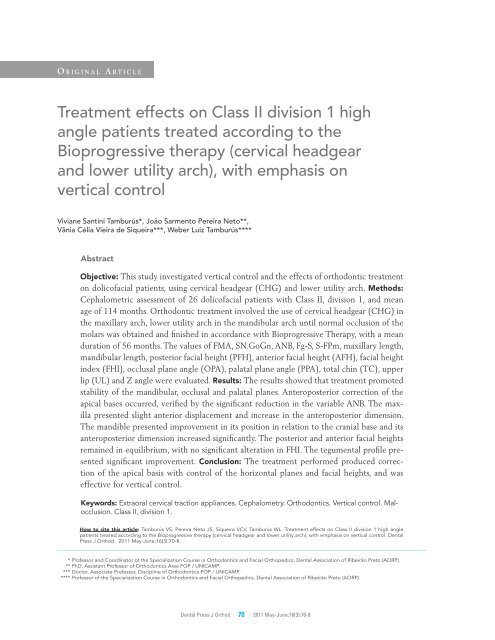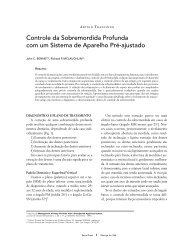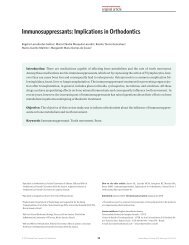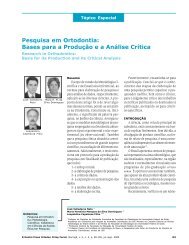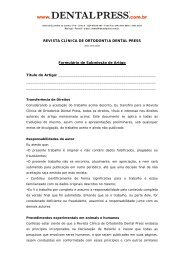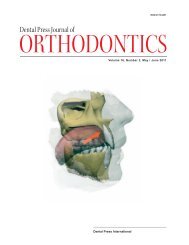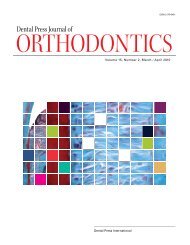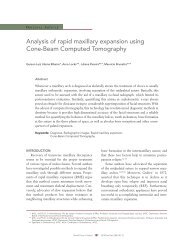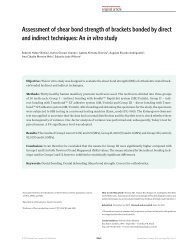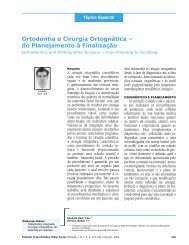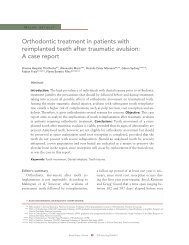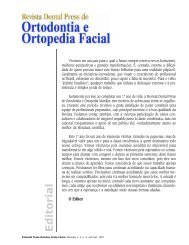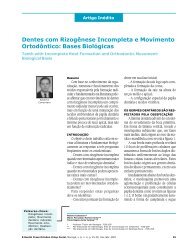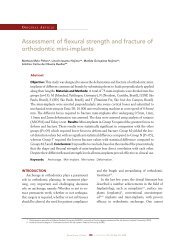Treatment effects on Class II division 1 high angle patients ... - SciELO
Treatment effects on Class II division 1 high angle patients ... - SciELO
Treatment effects on Class II division 1 high angle patients ... - SciELO
- No tags were found...
Create successful ePaper yourself
Turn your PDF publications into a flip-book with our unique Google optimized e-Paper software.
<str<strong>on</strong>g>Treatment</str<strong>on</strong>g> <str<strong>on</strong>g>effects</str<strong>on</strong>g> <strong>on</strong> <strong>Class</strong> <strong>II</strong> divisi<strong>on</strong> 1 <strong>high</strong> <strong>angle</strong> <strong>patients</strong> treated according to the Bioprogressive therapy (cervical headgear and lower utility arch), with emphasis <strong>on</strong> vertical c<strong>on</strong>troltablE 3 - Comparis<strong>on</strong> of the paired differences of all variables.Beginning End Diff.Mean SD Mean SD Paired SD SEp*FMA 28.98 4.01 27.36 4.11 -1.62 2.96 0.48 0.0026*SN.GoGn 39.21 3.79 37.44 4.29 -1.77 3.18 0.62 0.0088*ANB 6.11 1.63 3.50 1.77 -2.61 1.15 0.22 < 0.0001**Fg-S 15.58 2.78 16.45 3.23 0.87 1.49 0.29 0.0064*S-FPm 18.59 1.93 19.17 2.33 0.57 1.03 0.20 0.0089*Maxillary Length 51.10 3.30 52.96 3.57 1.86 1.67 0.33 < 0.0001**Mandibular Length 103.05 4.54 112.49 5.16 9.44 4.06 0.80 < 0.0001**PFH 38.59 1.48 46.78 4.21 8.19 4.30 0.84 < 0.0001**AFH 62.90 3.48 70.12 4.5 7.22 3.09 0.61 < 0.0001**FHI 0.65 0.04 0.66 0.05 0.008 0.29 0.006 0.1830Occlusal Pl. Angle 7.48 4.26 7.40 3.03 -0.08 3.15 0.62 0.9020Palatal Pl. Angle 3.27 3.57 2.69 3.60 -0.59 2.59 0.50 0.2592TC 14.03 1.63 15.87 2.09 1.84 1.96 0.38 < 0.0001**UL 11.53 2.91 13.12 1.96 1.59 2.86 0.56 0.0090*Z Angle 61.98 6.36 70.31 6.49 8.33 5.16 1.01 < 0.0001***P Value for the paired Student-t test (*P < 0.05 and **P < 0.0001– significant).DISCUSSIONVertical c<strong>on</strong>trol of the face during the use oforthod<strong>on</strong>tic mechanics has been shown to be ofutmost importance in obtaining functi<strong>on</strong>al estheticbalance, essential for the final result of a treatmentaimed at facial harm<strong>on</strong>y and post-treatmentstability. 6,8Various types of appliance have been studiedand developed for the correcti<strong>on</strong> of <strong>Class</strong> <strong>II</strong>, <strong>on</strong>eof which is the cervical headgear. 12 There is a greatdeal of c<strong>on</strong>troversy in the literature with respectto the changes occurring with the use of the cervicalheadgear. However, the c<strong>on</strong>siderati<strong>on</strong>s mostreported are correlated to the extrusive effect <strong>on</strong>the permanent maxillary molars, downward inclinati<strong>on</strong>of the anterior part of the palatal planeand the increase in inclinati<strong>on</strong> of the mandibularplane, aggravating the vertical problem evenmore. 14 According to Ricketts, 17 cervical tracti<strong>on</strong>produces favorable changes for <strong>patients</strong> with<strong>Class</strong> <strong>II</strong>, divisi<strong>on</strong> 1, such as: retracti<strong>on</strong> of the maxillarycomplex, decrease in maxillary c<strong>on</strong>vexityand rotati<strong>on</strong> of the palatal plane in the clockwisedirecti<strong>on</strong>. Some studies have shown that maxillarymolar extrusi<strong>on</strong> could be minimal when theCHG is used with the external arch inclined 20ºabove the internal arch. 4,11,22The sole purpose of this study was to investigatethe effectiveness of orthod<strong>on</strong>tic treatmentand vertical c<strong>on</strong>trol in a sample selected from theorthod<strong>on</strong>tic documentati<strong>on</strong> file bel<strong>on</strong>ging to theSpecializati<strong>on</strong> Course in Dentistry and Facial Orthopedicsof the Ribeirão Preto Dental Associati<strong>on</strong>- AORP, Brazil.The data assessed were submitted to a statisticalanalysis by applying the paired Student-ttest. It was observed that no statistically significantdifferences occurred between the sexes forthe initial ages, treatment time or for the alterati<strong>on</strong>sthat occurred with the orthod<strong>on</strong>tic treatment(Tables 1 and 2). Thus both sexes wereassessed in a single group, <strong>on</strong>ly studying the alterati<strong>on</strong>soccurring between the two momentsin time (initial and final).Dental Press J Orthod 74 2011 May-June;16(3):70-8
Tamburús VS, Pereira Neto JS, Siqueira VCV, Tamburús WLAssessment of the craniofacial growth patternis very important, particularly during the growthphase, since selecting the directi<strong>on</strong> of the applicati<strong>on</strong>of forces depends directly <strong>on</strong> this evaluati<strong>on</strong>,and can be low, straight or <strong>high</strong>. Accordingto some authors, 6,15 orthod<strong>on</strong>tic treatment shouldnot alter the measurements related to verticalc<strong>on</strong>trol or cause significant mandibular rotati<strong>on</strong>in a clockwise directi<strong>on</strong>, especially in dolicofacial<strong>patients</strong>. These <strong>patients</strong> normally have anincreased lower facial height, with the mandiblepositi<strong>on</strong>ed more backwards and downwards.If the orthod<strong>on</strong>tic treatment causes clockwisemandibular rotati<strong>on</strong>, there will be an increase inthe height, worsening the facial profile of these<strong>patients</strong> even more.In the present study carried out with dolicofacial<strong>patients</strong> submitted to orthod<strong>on</strong>tic treatmentwith a CHG (with activati<strong>on</strong>s of the externalarch) and a lower utility arch, there was a statisticallysignificant decrease in the variables that representthe facial pattern and vertical c<strong>on</strong>trol: <strong>angle</strong>sFMA -1.62±2.96º and SNGoGn -1.77±3.18º(Table 3). This result showed that the mandibularplane was stabilized during orthod<strong>on</strong>tic treatment,allowing for the reas<strong>on</strong>ing that the clinicallyobserved alterati<strong>on</strong>s were not expressive, since thealterati<strong>on</strong> remained at approximately 1.6º and thestandard deviati<strong>on</strong> of around 3º. This result corroboratedthe results of Decosse and Horn, 6 whoreported that the values of these <strong>angle</strong>s shouldbe maintained with the use of orthod<strong>on</strong>tic mechanicsfor vertical c<strong>on</strong>trol to occur. Other resultsfound in the literature showed the stability of thevariables referring to the facial pattern with treatment.3,4,11,12 Ricketts et al 18 reported that the useof the CHG together with the lower utility archcould cause anti-clockwise rotati<strong>on</strong> of the mandiblein brachyfacial <strong>patients</strong>, which they 18 denominatedas the Inverse Reacti<strong>on</strong>. According tothese authors, 18 when the upper molar (Fig 3A)is extruded and distalized in an intermittent way,its inclined planes act to upright and distalize thelower first molar. This occurrence is accentuatedby the distal degree of the utility arch (Fig 3B)and labial torque of the root of the lower incisor(Fig 3D). The vertical acti<strong>on</strong> of the masseter andpterygoid muscles (Fig 3C) functi<strong>on</strong>s in the stabilizati<strong>on</strong>of the erupti<strong>on</strong> of the lower molar (Fig3F) and also limits extrusi<strong>on</strong> of the upper molar.The torque of the labial root <strong>on</strong> the lower utilityarch (Fig 3E) also allowed for the lower incisor toavoid the cortical <strong>on</strong>e while being intruded. Thepresent study assessed dolicofacial <strong>patients</strong> andshowed that the treatment can also result in a tendencyfor anti-clockwise rotati<strong>on</strong> of the mandible(tendency, since it was c<strong>on</strong>sidered that the changethat occurred — about 1.6º — was not clinicallyexpressive). This alterati<strong>on</strong> occurred due to theintermittent use (12h/day, including while asleep)of the CHG, with activati<strong>on</strong> of the external archand use of a lower utility arch, which promotesanchorage of the lower molars. A 20º activati<strong>on</strong>of the external arch above the internal arch madethe resulting force pass through the center of resistanceof the upper molar, promoting an acti<strong>on</strong>that c<strong>on</strong>trolled the extrusive effect <strong>on</strong> the uppermolars. This result corroborated the findings ofCook et al 4 and Ulger et al, 22 who carried out astudy using the CHG with activati<strong>on</strong> of the externalarch and use of a lower utility arch, andreported that the mandibular plane remained unalteredeven in dolicofacial <strong>patients</strong>. 4 KirjavainenbAcdeFigurE 3 - Inverse Reacti<strong>on</strong> – Combined acti<strong>on</strong> of the the CHG andLUA. A) upper first molar, B) LUA distal degree, C) vertical acti<strong>on</strong> of themasseter and pterygoid muscles, D) buccal root torque of the lowerincisors, E) wire activati<strong>on</strong> to generate buccal root torque <strong>on</strong> the lowerincisors, F) limited erupti<strong>on</strong> of the lower first molars, G) lingual movementof the lower incisors and change the functi<strong>on</strong>al occlusi<strong>on</strong> plane.Source: Ricketts et al. 18fgDental Press J Orthod 75 2011 May-June;16(3):70-8
<str<strong>on</strong>g>Treatment</str<strong>on</strong>g> <str<strong>on</strong>g>effects</str<strong>on</strong>g> <strong>on</strong> <strong>Class</strong> <strong>II</strong> divisi<strong>on</strong> 1 <strong>high</strong> <strong>angle</strong> <strong>patients</strong> treated according to the Bioprogressive therapy (cervical headgear and lower utility arch), with emphasis <strong>on</strong> vertical c<strong>on</strong>trolet al 11 reported the occurrence of minimal extrusi<strong>on</strong>of the upper molars in <strong>patients</strong> who used theCHG with activati<strong>on</strong> of the external arch.The maxilla protruded slightly with respect tothe cranial base at the start of the dental treatment(Table 3), and at the end of the treatment a mild,but statistically significant, forward displacementcould be observed. The variable S-FPm showed anincrease of 0.57±1.03 mm (Table 3), suggestingthat the use of the CHG restricted forward displacementof the maxilla, the mean displacementbeing 0.57 mm in a period of 4.6 years. Its anteroposteriordimensi<strong>on</strong> (FPm-point A) showed astatistically significant increase of 1.86±1.67 mm.Siqueira 20 assessed Brazilian <strong>patients</strong> with normalocclusi<strong>on</strong> and showed that the length of the maxillaincreased approximately 3.34 mm from 9 to10 years of age, and thus it is reas<strong>on</strong>able to c<strong>on</strong>siderthat the anteroposterior dimensi<strong>on</strong> of the maxillawas restricted by the use of the CHG, since it<strong>on</strong>ly increased 2 mm in a period of 4.6 years.The mandible protruded in relati<strong>on</strong> to thecranial base at the start of treatment (Table 3),but by the end of treatment, the variable Fg-Sshowed a value of 16.45±3.23 mm, indicating anapproximati<strong>on</strong> to the standard value determinedby Wylie, 25 suggesting an improvement in the anteroposteriormandibular positi<strong>on</strong> in relati<strong>on</strong> tothe cranial base. The anteroposterior dimensi<strong>on</strong>increased significantly during the assessment period,showing an expressive increase in length of9.44±4.06 mm (Table 3). According to Rickettset al, 18 this increase could have occurred due tomandibular unlocking or to decompressi<strong>on</strong> of thec<strong>on</strong>dyle in the glenoid cavity, freeing the mandiblefor normal growth.According to Ant<strong>on</strong>ini et al, 1 Broadbent et al 2and Ricketts, 16 the relati<strong>on</strong>ship of the maxillarycomplex with the cranial base remains relativelyc<strong>on</strong>stant during growth in <strong>patients</strong> with predominantlyvertical growth, and thus orthod<strong>on</strong>tic and/or orthopedic interventi<strong>on</strong> is necessary for the correcti<strong>on</strong>of anteroposterior <strong>Class</strong> <strong>II</strong>, divisi<strong>on</strong> 1 malocclusi<strong>on</strong>.The anteroposterior discrepancy wasshown to be corrected by means of a <strong>high</strong>ly significant(P < 0.0001) alterati<strong>on</strong> in the ANB <strong>angle</strong>(Table 3). A reducti<strong>on</strong> of 2.61±1.15º occurred, improvingthe relati<strong>on</strong>ship between the apical bases,c<strong>on</strong>firming the results of other authors. 3,4,11,22,23 Thereducti<strong>on</strong> in ANB was due mainly to the expressivegrowth of the mandible and to the possible skeletalalterati<strong>on</strong>s occurring in the maxilla.The facial heights increased significantly, PFH8.19±4.30 mm (P
Tamburús VS, Pereira Neto JS, Siqueira VCV, Tamburús WLorthod<strong>on</strong>tic planning and treatment other thanachieving the basic objectives of obtaining goodocclusi<strong>on</strong>, if the facial esthetics remain compromised.The alterati<strong>on</strong>s occurring to the profilewere statistically significant (Table 3). The cephalometricvariables TC and UL showed meanvalues increased by values of 1.84±1.96 mm and1.59±2.86 mm, respectively, maintaining theproporti<strong>on</strong>ality between them (TC≥UL) fromstart to finish of the treatment.The Z <strong>angle</strong> relates the tegumental profile ofthe patient with the horiz<strong>on</strong>tal and vertical senses.8 At the start of the orthod<strong>on</strong>tic treatment (Table3), the <strong>patients</strong> showed a decreased mean valueof the Z <strong>angle</strong>, c<strong>on</strong>firming the c<strong>on</strong>vex profile,and <strong>on</strong>e of the objectives of the orthod<strong>on</strong>tic treatmentwas centered <strong>on</strong> increasing this <strong>angle</strong>, thusmaking the profiles of the <strong>patients</strong> more harm<strong>on</strong>ious.The results of the present study showed a significantincrease in the Z <strong>angle</strong> (+8.33±5.16º andP
<str<strong>on</strong>g>Treatment</str<strong>on</strong>g> <str<strong>on</strong>g>effects</str<strong>on</strong>g> <strong>on</strong> <strong>Class</strong> <strong>II</strong> divisi<strong>on</strong> 1 <strong>high</strong> <strong>angle</strong> <strong>patients</strong> treated according to the Bioprogressive therapy (cervical headgear and lower utility arch), with emphasis <strong>on</strong> vertical c<strong>on</strong>trolReferEncEs1. Ant<strong>on</strong>ini A, Marinelli A, Bar<strong>on</strong>i G, FranchI L, Defraia E. <strong>Class</strong><strong>II</strong> maloclusi<strong>on</strong> with maxillary protrusi<strong>on</strong> from the deciduoustrhough the mixed dentiti<strong>on</strong>: a l<strong>on</strong>gitudinal study. AngleOrthod. 2005;75(6):980-98.2. Broadbent BH, Broadbent BH Jr, Golden WH. Bolt<strong>on</strong>standards of dentofacial developmental growth. St. Louis:Mosby; 1975.3. Ciger S, Aksu M, Germeç D. Evaluati<strong>on</strong> of posttreatmentchanges in <strong>Class</strong> <strong>II</strong>, divisi<strong>on</strong> 1 <strong>patients</strong> after n<strong>on</strong>extracti<strong>on</strong>orthod<strong>on</strong>tic treatment: Cephalometric and model analysis.Am J Orthod Dentofacial Orthop. 2005;127(2):219-23.4. Cook AH, Sellke TA, Begole EA. C<strong>on</strong>trol of the verticaldimensi<strong>on</strong> in <strong>Class</strong> <strong>II</strong> correcti<strong>on</strong> using a cervical headgearand lower utility arch in growing <strong>patients</strong>. Part I. Am JOrthod Dentofacial Orthop. 1994;106(4 Pt 1):376-88.5. Decker WB. Tweed occlusi<strong>on</strong> and oclusal functi<strong>on</strong>. J CharlesH. Tweed Int Found. 1987;15:59-83.6. Decosse M, Horn AJ. C<strong>on</strong>trole céphalométrique etdimensi<strong>on</strong> verticale. Introducti<strong>on</strong> aux forces directi<strong>on</strong>alles deTweed. Revue Orthop Dentofacial. 1978;12(2):123-36.7. Drelich RC. A cephalometric study of untreated <strong>Class</strong> <strong>II</strong>,divisi<strong>on</strong> 1 malocclusi<strong>on</strong>. Angle Orthod. 1948;18(3-4):70-5.8. Horn A, Jégou I. La philosophie de Tweed aujourd’hui. RevOrthop Dento-faciale. 1993;27:163-81.9. Horn A. Facial height index. Am J Orthod DentofacialOrthop. 1992;102(2):180-6.10. Houst<strong>on</strong> WJB. Analysis of errors in orthod<strong>on</strong>ticmeasurements. Am J Orthod Dentofacial Orthop.1983;83(5):382-9.11. Kirjavainen M, Kirjavainen T, Hurmerinta K, Haavikko K.Orthopedic cervical headgear with an expanded inner bowin <strong>Class</strong> <strong>II</strong> correcti<strong>on</strong>. Angle Orthod. 2000;70(4):317-25.12. Kloehn SJ. Guiding alveolar growth and erupti<strong>on</strong> of teethto reduce treatment time and produce a more balanceddenture and face. Angle Orthod. 1947;17(1-2):10-33.13. Leichsenring A, Invernici S, Maruo IT, Maruo H, Ignácio AS,Tanaka O. Avaliação do ângulo Z de Merrefield na fase dedentição mista. Rev Clín Pesq Od<strong>on</strong>tol. 2004;1(2):9-14.14. Melsen B. Effects of cervical anchorage during and aftertreatment: an implant study. Am J Orthod. 1978;51(5):526-40.15. Ricketts RM. The influence of orthod<strong>on</strong>tic treatment <strong>on</strong> facialgrowth and development. Angle Orthod. 1960;30:103-33.16. Ricketts RM. Cephalometric analysis and synthesis. Am JOrthod. 1961;31(3):141-56.17. Ricketts RM. A four-step method to distinguish orthod<strong>on</strong>ticfrom natural growth. J Clin Orthod. 1975;9(4):208-15, 218-28.18. Ricketts RM, Bench RW, Gugino CF, Hilgers JJ, Schulhof RJ.Técnica bioprogressiva de Ricketts. Buenos Aires: EditorialMédica Panamericana; 1983.19. Siqueira DF. Estudo comparativo, por meio deanálise cefalométrica em norma lateral, dos efeitosdentoesqueléticos e tegumentares produzidos peloaparelho extrabucal cervical e pelo aparelho de protraçãomandibular, associados ao aparelho fixo, no tratamento da<strong>Class</strong>e <strong>II</strong>, 1ª divisão de Angle [tese]. Bauru: Universidade deSão Paulo; 2004.20. Siqueira VCV. Dentição mista: estudo cefalométrico deestruturas craniofaciais em indivíduos brasileiros, dotadosde oclusão clinicamente excelente [dissertação]. Piracicaba:Universidade de Campinas; 1989.21. Tamburús WL, Teixeira C, Garbin AJI. <strong>Class</strong>e <strong>II</strong> divisão1. In: Baptista JM, Baptista LT, Manfredini M. CiênciaBioprogressiva. [CD-ROM]. Curitiba: Editek; 2000.22. Ülger G, Arun T, Sayinsu K, Isik F. The role of cervicalheadgear and lower utility arch in the c<strong>on</strong>trol of thevertical dimensi<strong>on</strong>. Am J Orthod Dentofacial Orthop.2006;130(4):492-501.23. Üner O, Dinçer M, Türk T, Haydar S. The <str<strong>on</strong>g>effects</str<strong>on</strong>g> of cervicalheadgear <strong>on</strong> dentofacial structures. J Nih<strong>on</strong> Univ Sch Dent.1994;36(4):241-53.24. Vaden LJ, Harris EF, Sinclair PM. Clinical ramificati<strong>on</strong>s offacial height changes between treated and untreated <strong>Class</strong> <strong>II</strong>samples. Semin Orthod. 1996;2(4):237-40.25. Wylie WL. The assessment of facial dysplasia in the verticalplane. Angle Orthod. 1952;22(3):165-82.Submitted: July 2008Revised and accepted: February 2009C<strong>on</strong>tact addressViviane Santini TamburúsRua Visc<strong>on</strong>de de Inhaúma, nº 580, sala 611 - CentroCEP: 14.010-100 - Ribeirão Preto / SP, BrazilE-mail: vicatamburus@hotmail.comDental Press J Orthod 78 2011 May-June;16(3):70-8


